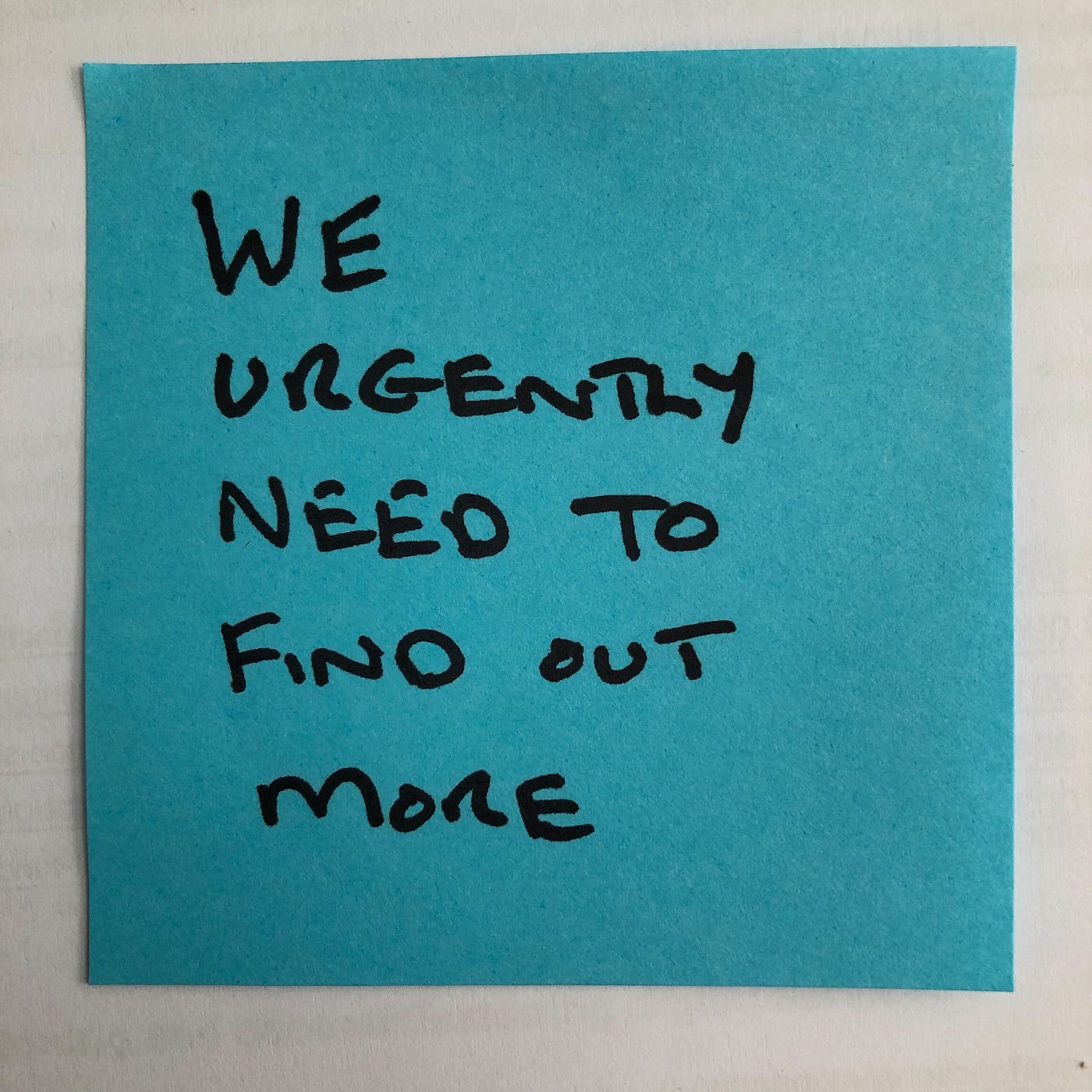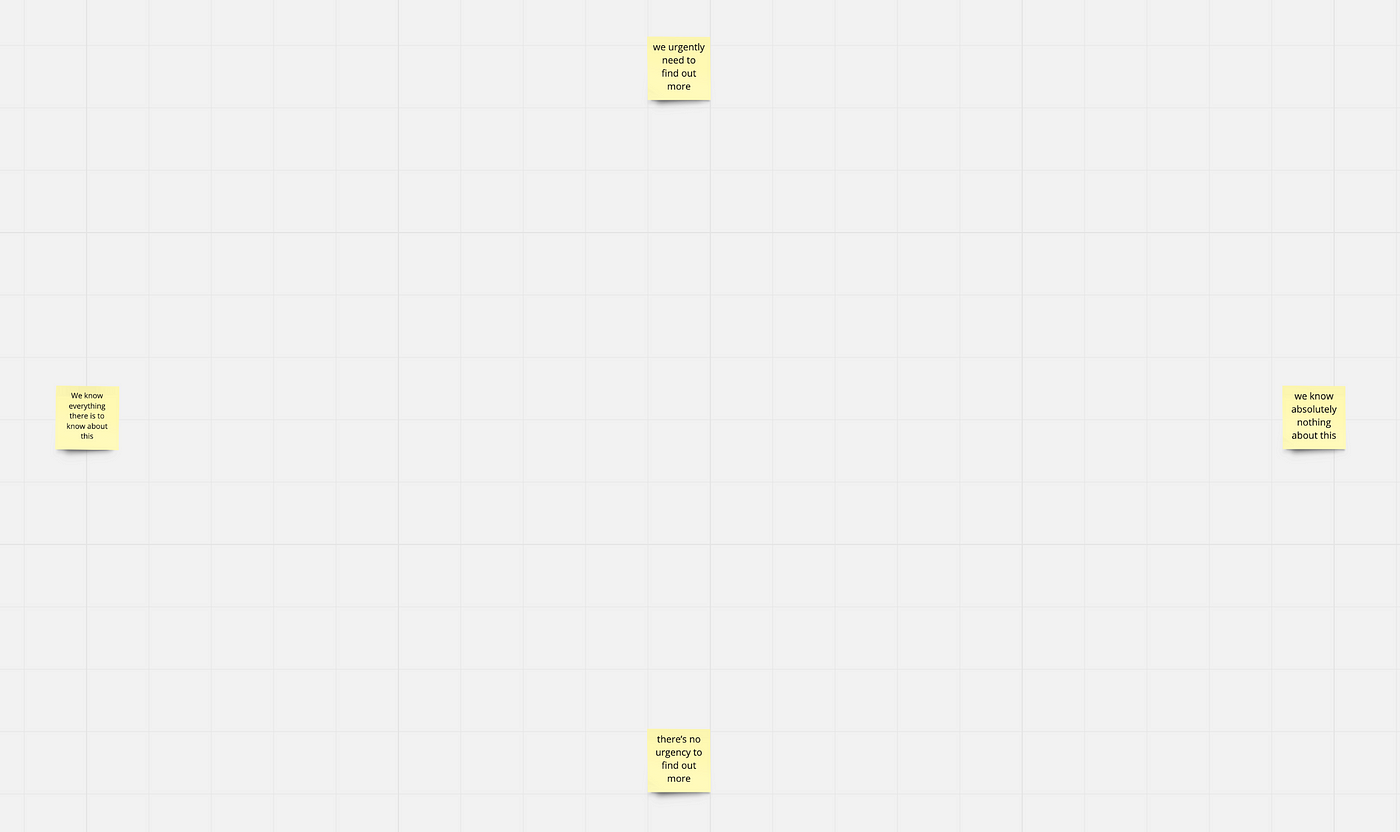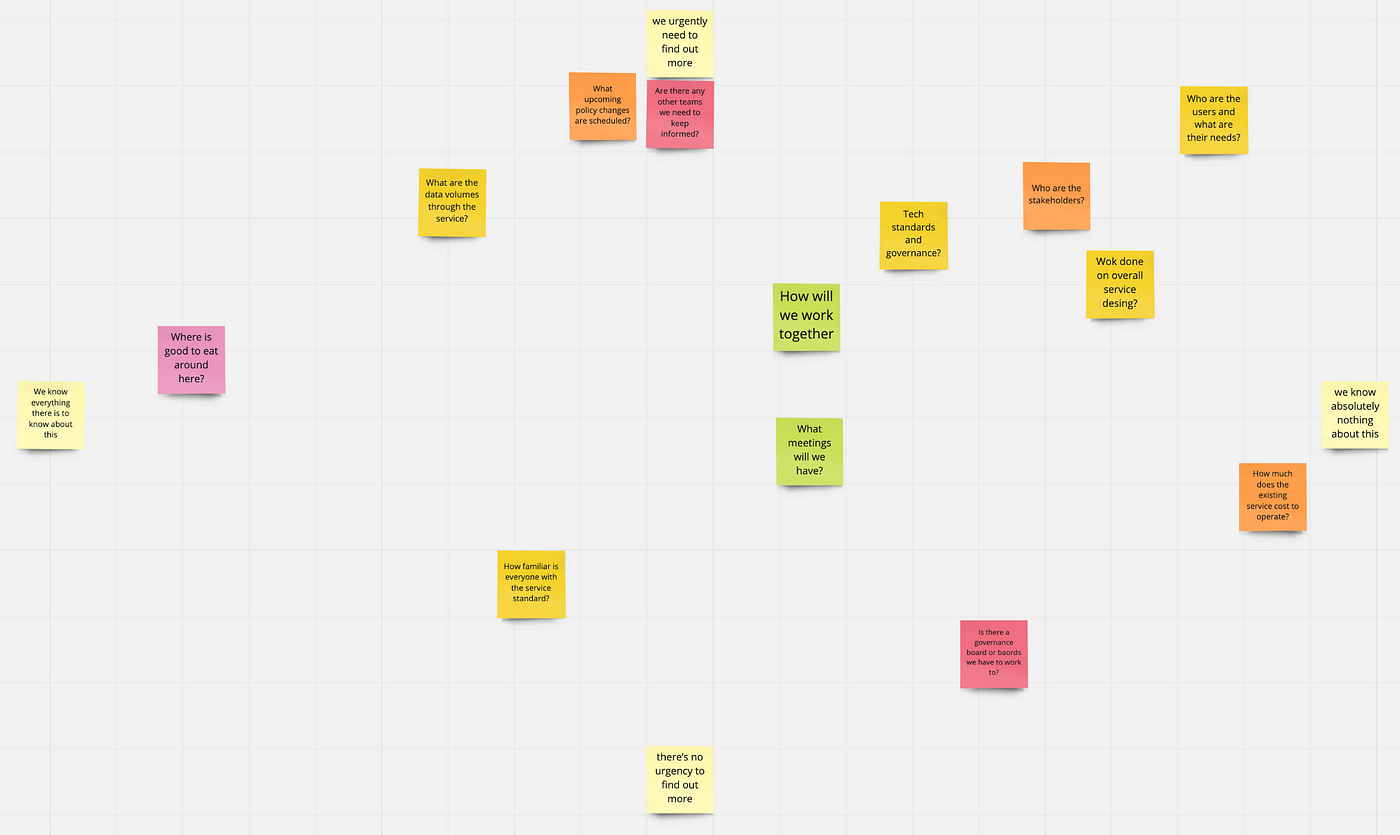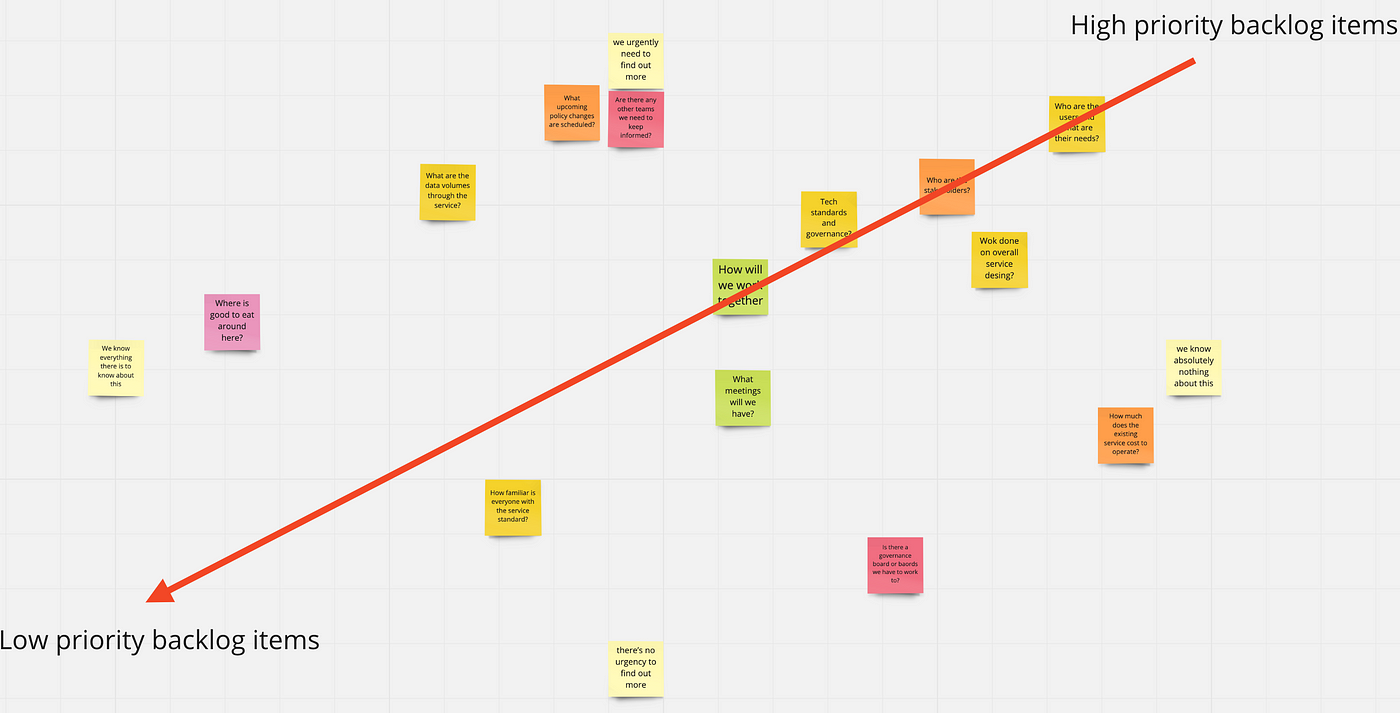I’m often asked to help teams kick off their Discovery projects — to help set them up for their first week or so of work — and I usually do this in one or two kickoff workshops where we have some getting to know each other and some getting to know the work activities.
One of the activities I usually run I call the known/unknown activity. This helps teams generate a prioritised backlog to get them started. I’ll describe the activity and how I run it in this post. I most often work in government these days so some of things I’ll write about will only be applicable to that domain but much of it applies to Discovery in any domain and some of it to any occasion when a new team is picking up unfamiliar work.

What are Discoveries about?
Discoveries are about understanding one or more problems to be solved. So, Discoveries are focussed on research rather than ‘building’. Discovery teams have to find stuff out and they use techniques such as user research, business analysis and technology mapping to better understand the problem domain.
The known/unknown activity helps teams:
- understand what they collectively already know,
- begin to share knowledge in the team and
- prioritise work to learn more about those things they don’t know much about.
Who’s in a Discovery team?
In a government setting Discovery teams are often made up of civil servants and contractors (who are often ‘Digital’ specialists). The exact mix of the team will depend on the Digital maturity of the organisation, the nature of the problem to be solved and the budget and duration of the Discovery. It often includes Policy specialists from the organisation who understand the broad policy landscape and data about a sector. They may have also been involved in earlier attempts to tackle a problem or at least be aware of those attempts and already have some ideas about which problem(s) to focus on and how those problems might be tackled .
Usually though, some, or many of the team are new to the problem domain and need to get up to speed and be productive very quickly — government Discoveries are intentionally short and pacy to force teams to focus on what’s important.
Running a known/unknown activity
As with many activities you start with a blank wall (or online equivalent) and a few packs of post-its and sharpies.
Mark out an X-axis on the wall — this will be your knowledge axis — label the left end with a post-it with the words “we know everything there is to know about this” and the right end with a post-it with the words “we know absolutely nothing about this”. You can do this before the team arrives if you manage to get access to the wall ahead of time.

knowledge axis — your X axis
Next mark out a Y-axis on the wall — this will be your urgency axis — label the top with a post-it with the words “we urgently need to find out more” and the bottom with a post-it with the words “there’s no urgency to find out more”.

knowledge and urgency axes
Identifying topics
The first part of the activity involves the team coming up with topics that relate to their Discovery project, particularly the problem to be explored, and writing these on post-its. I usually give people 15–20 minutes of working on their own or in pairs to come up with these topics.
To help people brainstorm topics I give them a set of written prompts — either as handouts, or as posters on the wall if the room layout allows. (I say more about the prompts later).
Next, everyone puts their post-its on the wall according to how much knowledge they have about the topic, placing post-its nearer the left end of the axis if they know something about the topic and nearer the right end if they know little about the topic. Don’t use the full height of the wall at this stage, just keep the post-its in a line as far as possible. They also don’t discuss the topics or the positioning at this stage, just work to get all the topics onto the wall. Tip: try and use as much of the breadth of the wall as possible, don’t just bunch things together.

Partially completed knowledge axis
Consolidating topics
Once they have placed the post-its, they all look over the entire wall to see what everyone has written and people can ask for clarification if they need more explanation on the topic written on the post-it.
Next, you can look for duplicates or similar post-its and consolidate them if possible. I typically start at the “we know absolutely nothing about this” end of the wall and work towards the “we know everything there is to know about this” end.
When you see post-its to be merged they are likely to be at different positions on the knowledge axis and this is where the team can discuss how much (or little) knowledge they as a team do have in practice — it may be for example that a newcomer to the team doesn’t know much about a topic and has placed it to the right of the axis, but people who understand the problem domain and have been around a while know lots more and in this case you can move the post-it to the left since the team collectively knows more about it. With this discussion it should become a bit clearer who knows what already so that people who are less familiar can learn from them. You might also decide that topics should be split — for example if you know a lot about some aspect of a topic but don’t know much about some other aspect. New topics might also emerge during discussions and these can be added to the wall as you go.
Establishing urgency
Once you’ve made a pass through the topics and adjusted them on the knowledge axis, if needed, you can move onto establishing urgency for each topic.
Again, I generally work from the “we know absolutely nothing about this” end of the wall and work towards the “we know everything there is to know about this” end.
Take each topic in turn and discuss as a group where to reposition it on the vertical axis based on how urgent it is to find out more about the topic. If it’s really, really urgent — then near the top of the axis — if it really isn’t that urgent at all, then near the bottom of the axis. Note that it’s important at this stage not to accidentally adjust the topic’s position on the horizontal axis — you’ll undo good work from the first part of the activity if you do that.
A common mistake here is to make everything urgent but try and use the full height of the wall to spread things out and decide between yourselves whether two equally urgent things are actually equal in urgency and adjust their positions accordingly.
It’s still OK to add new topics, and consolidate or split topics at this stage but if you do, remember to position them where you want them on the knowledge and urgency axes.
Working with a team for an hour or so we usually generate 40–50 topics to position on the axes. (Example below is entirely fictional!)

Wholly fictional completed known/unknown activity — note additional post-its added over previous screenshot
The backlog
Your initial backlog can now be read off the wall from top-right to bottom-left i.e. from the things you know least about that it’s most urgent you find out more about to things you know most about and it’s not at all urgent you find out more about them.

Backlog priority
Now of course this isn’t an exact science so you don’t have to spend hours debating whether one thing or another is of higher priority. You should just get a general sense of the sorts of things your should be focussing on in your first week or two and (more importantly) the sorts of things you you don’t yet need to be focussing on. You’ll be changing the priority of things in your backlog, adding things and removing things as you learn more about the work. This activity is about getting you going from a standing start.
Prompts for generating topics
People’s topic post-its can have absolutely anything related to the work written on them — policy, tech, people, timelines, tools, ways of working etc. I use a set of prompts to help generate topic these topics and help make sure that a broad set of topics is considered.
Here are some examples:
What’s the vision for this work? What are the timescales? What goals do we have? How have we arrived at the goals? How would we know when to stop work? How will we know when a goals is satisfied?
How does this work relate to departmental or political priorities? How much do we know about how the Director General (or other HIPPOs) is thinking or the Minister(s)?
Who are our users? How much do we know about them? What prior research is there? How do we access that research? How good is it — recency, quality, method? What do we know about the user journey? Are there groups of users?
Why should the users use your product or service? Is it compulsory or optional? For optional services, what alternatives might users already use? What makes your service better?
How much do we know about a roadmap? How flexible is it? Are there any critical dates?…
What is the policy in this area? How much do we know about it? Are there any new policy initiatives that affect our work? How hard are any new policy initiatives and how soft (i.e. where’s the flexibility?)
What are the legal duties in the space? Any new laws coming into effect?
Who are the core team? How much do we know about them? Have they worked together before? What experience do they have?
Who is the (wider) team? Who are our stakeholders? How much do we know about their views?
What other projects are on-going that we need to speak to? How much do we know about them? What sort of collaboration do we need to have with them? Are there any people outside the directorate / division / organisation that affect the project? How do we reach them?
Who else (in Government) can we learn from?
What (legacy) services exist? How much do we know about plans to replace or evolve them? Are there any contractual deadlines coming up? Who owns and runs the services? Do we have data on their operations?
Are there any technology projects that affect our platform?
What data exists in our space? Who owns the data? How do we access it? How up to date is it? What’s there? What’s missing?
Are there any reports we should read — Business Analysis, external market, trade body, teacher body…?
Are there any issues around comms, the press? What’s already been said? What’s our line?
Are there any restrictions on our activities? Pre-election sensitivities? Legal sensitivities? Commercial issues?
What will our ways of working be? When will our team meet? Where will we sit? What facilities do we need? What will our meeting cycle be?
For teams new to Discovery: How much do you know about Discoveries? What are you more or less certain about? (similarly for teams new to agile, or user research or…)
What are we not doing that people might think we’re doing? Are there any rabbit holes we should avoid going down? (Got these from someone else but can’t remember where, sorry!)
Tips on Facilitating the activity
Don’t let debate drag on, the activity is for prioritising not solving
Don’t try and place the post-its on both axes at once. This can lead to extended discussions.
Splitting post-its might work if there’s disagreement on where to place something.
When working on the urgency axis, do feel free to consciously adjust the position on the knowledge axis as your discussion reveals more (or less) knowledge than you thought. Get agreement on where to reposition. Don’t adjust the horizontal position accidentally!
If you have a big group, then ahead of time, think about a few bigger topics that will be of relevance / interest to a few folks and run parallel known/unknown activities where you get people to populate a known/unknown wall for that bigger topic e.g. in one kickoff I ran for c. 30 people I had 6 activities going concurrently with topics such as ‘Design’, ‘Technology’, ‘Finance and Business Cases’, I nominated a facilitator to stick with a topic for the whole session and then asked every one else to pick a wall and begin there but after 30 minutes gave everyone but the nominee a chance to move around. After 3–4 iterations I asked each nominee to play back what they had on their wall. (This was modified world cafe format for those who want to try it).
Close
I’ve probably run this activity about 30 times since 2016 on physical and virtual walls and it’s always produced good results.
Let me know below in the comments if you try the activity and how it went.


